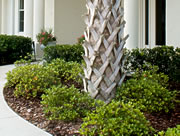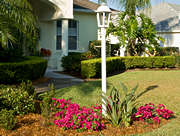Plant spacing
- Home
- /
- Technical Manual
- /
- Landscape criteria
- /
- General practices
- /
- Plant spacing
Background
Densely spaced plants, or instant landscapes, can appreciably increase a landscape’s watering and maintenance requirements, which is contrary to water-efficiency practices of Florida Water Star. Often plantings are in proximity to each other to give the appearance of a mature landscape at the time of building occupancy. However, as plants mature, there is insufficient space for plants to establish and thrive, which can increase the need for irrigation, nutrition and pesticide applications due to stressed conditions. For the purposes of Residential Florida Water Star, plant beds should be designed so that, at maturity, they have a 60 percent cover.
Requirements and certification
Plants are spaced for growth to maturity.
| Silver | Gold | Commercial/Institutional |
|---|---|---|
| NA | NA | Required |
Evaluating the density of plant species and growth rates can be subjective. During the landscape design process, landscape designers should use mature widths from the Waterwise plant database, or other accepted reference, to determine the number of plants and spacing. For Residential Florida Water Star, the designer must plan for the installation of sufficient plants so that, at maturity, plants will cover 60 percent of the bed.
| Design Requirements for Establishing Plant Spacing | |
|---|---|
| Information | Document |
| Documentation of growth rate and mature size | Plant list |
| Clear specification of plant location on the landscape design | Landscape design |
Inspectors should review the landscape design prior to installation to ensure that the landscape installer uses the design-specified species and recommended plant spacing.
The following figure from the Waterwise plant database provides information for the Mary Nell holly. The mature width range is from 10 feet to 15 feet, meaning that this tree should be planted at least 5 feet to 7.5 feet from adjacent plants or structures.
Program tip
If the landscape professional has a valid reason to exceed the recommended spacing of a species, an explanation may be submitted for consideration by the Inspector.
Florida Water Star residential certifications address plant spacing by insuring sufficient plants are installed to allow for 60 percent cover at maturity, are site-appropriate and that plants are grouped with similar moisture and maintenance requirements.



